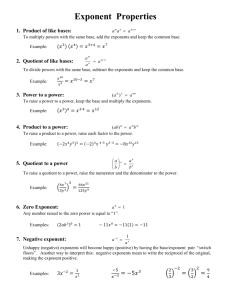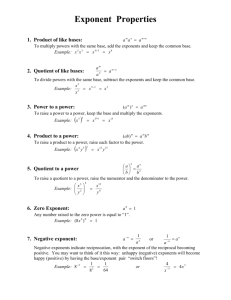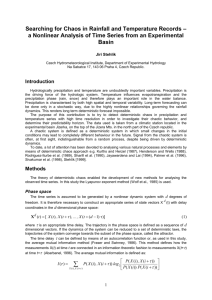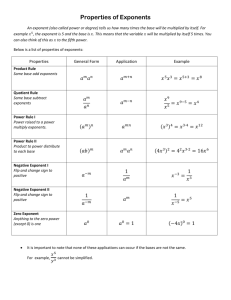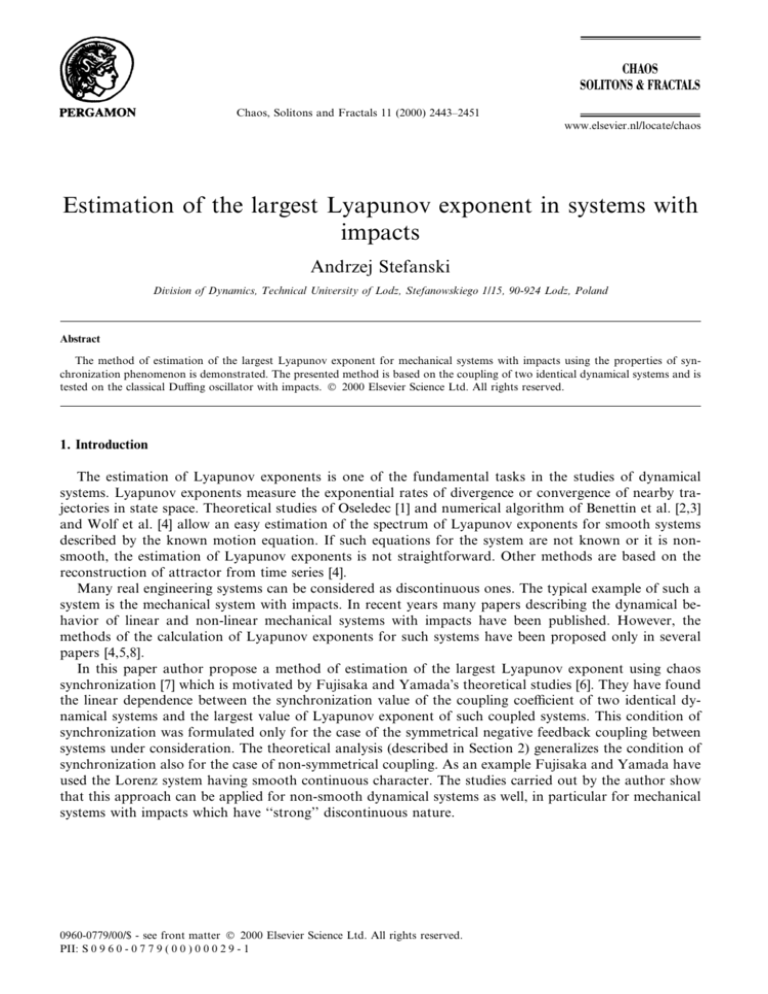
Chaos, Solitons and Fractals 11 (2000) 2443±2451
www.elsevier.nl/locate/chaos
Estimation of the largest Lyapunov exponent in systems with
impacts
Andrzej Stefanski
Division of Dynamics, Technical University of Lodz, Stefanowskiego 1/15, 90-924 Lodz, Poland
Abstract
The method of estimation of the largest Lyapunov exponent for mechanical systems with impacts using the properties of synchronization phenomenon is demonstrated. The presented method is based on the coupling of two identical dynamical systems and is
tested on the classical Dung oscillator with impacts. Ó 2000 Elsevier Science Ltd. All rights reserved.
1. Introduction
The estimation of Lyapunov exponents is one of the fundamental tasks in the studies of dynamical
systems. Lyapunov exponents measure the exponential rates of divergence or convergence of nearby trajectories in state space. Theoretical studies of Oseledec [1] and numerical algorithm of Benettin et al. [2,3]
and Wolf et al. [4] allow an easy estimation of the spectrum of Lyapunov exponents for smooth systems
described by the known motion equation. If such equations for the system are not known or it is nonsmooth, the estimation of Lyapunov exponents is not straightforward. Other methods are based on the
reconstruction of attractor from time series [4].
Many real engineering systems can be considered as discontinuous ones. The typical example of such a
system is the mechanical system with impacts. In recent years many papers describing the dynamical behavior of linear and non-linear mechanical systems with impacts have been published. However, the
methods of the calculation of Lyapunov exponents for such systems have been proposed only in several
papers [4,5,8].
In this paper author propose a method of estimation of the largest Lyapunov exponent using chaos
synchronization [7] which is motivated by Fujisaka and YamadaÕs theoretical studies [6]. They have found
the linear dependence between the synchronization value of the coupling coecient of two identical dynamical systems and the largest value of Lyapunov exponent of such coupled systems. This condition of
synchronization was formulated only for the case of the symmetrical negative feedback coupling between
systems under consideration. The theoretical analysis (described in Section 2) generalizes the condition of
synchronization also for the case of non-symmetrical coupling. As an example Fujisaka and Yamada have
used the Lorenz system having smooth continuous character. The studies carried out by the author show
that this approach can be applied for non-smooth dynamical systems as well, in particular for mechanical
systems with impacts which have ``strong'' discontinuous nature.
0960-0779/00/$ - see front matter Ó 2000 Elsevier Science Ltd. All rights reserved.
PII: S 0 9 6 0 - 0 7 7 9 ( 0 0 ) 0 0 0 2 9 - 1
2444
A. Stefanski / Chaos, Solitons and Fractals 11 (2000) 2443±2451
2. Theoretical assumptions of the method
Consider a dynamical system which is composed of two identical n-dimensional subsystems coupled by
one-to-one negative feedback mechanism with a pair of coupling coecients dx and dy . The ®rst order
dierential equations describing such a system can be written as
x_ f
x dx
y ÿ x;
y_ f
y dy
x ÿ y;
1
T
where x; y 2 Rn and dx;y dx;y ; dx;y ; . . . ; dx;y 2 Rn P 0 is a coupling vector. LetÕs assume that for
dx dy 0 each of the subsystems of system (1) evolves on an asymptotically stable chaotic attractor A.
In further analysis to simplify the notation and allow for the visualization the value n 3 is taken and it
is assumed that the evolution on the attractor A is characterized by one positive Lyapunov exponent.
Let us now introduce a new variable z representing the state dierence between both subsystems during
the time evolution. This variable is de®ned by the expression
z x ÿ y;
2
where z 2 Rn . The absolute value of state dierence
k~
zk jx ÿ yj;
3
describes the norm (k~
zk 2 R1 P 0) of the state dierence vector
~
z ~
x ÿ~
y:
4
The image of the vector equation (Eq. (4)) in phase space is shown in Fig. 1. The state dierence vector is
®xed to the end of vector ~
y and its end is in touch with the end of vector ~
x (see Fig. 1). The time evolution of
zi
the state dierence vector ~
z is de®ned in zi system of coordinates and can be determined as a sum of its ~
contributions in all directions of phase space
~
z
n
X
~
zi :
5
i1
The origin of this system is ®xed to the origin of vector ~
z. The axes of zi -directions are parallel to the
appropriate axes of phase space.
The condition of full synchronization state between coupled subsystems of the system (1) is given by the
relation
k~
zk jx ÿ yj 0:
6
Fig. 1. The image of the vector equation (Eq. (4)) in phase space.
A. Stefanski / Chaos, Solitons and Fractals 11 (2000) 2443±2451
2445
Substituting Eq. (2) in Eq. (1) we obtain
x_ f
x ÿ dx z;
y_ f
y dy z:
7
The time evolution of the state dierence is given by ®rst time derivative of Eq. (2)
z_ x_ ÿ y_ ;
8
and can be written as a subtraction of both parts of Eq. (7)
z_ f
x ÿ f
y ÿ
dx dy z:
9
After putting the expression y x ÿ z (arising from Eq. (2)) in Eq. (9) we can rewrite the system under
consideration (Eq. (1)) in the following form:
x_ f
x ÿ dx z;
z_ f
x; z ÿ
dx dy z:
10
In Eqs. (9) and (10) the relation describing time evolution of state dierence is given clearly. We can see that
in the synchronized state
z 0 the motion on the attractor of the analyzed system (Eqs. (1) or (10)) (in
2n-dimensional phase space) reduces to the motion on the attractor of one of its identical subsystems (in
n-dimensional phase space).
In further analysis two forms of Eqs. (1) and (10) are considered:
1. with zero coupling coecients
dx dy 0 and non-zero system parameters;
2. with non-zero coupling coecients and zero system parameters
f
x f
y 0.
2.1. Positive Lyapunov exponent eect
In the ®rst of the above cases
dx dy 0 the equations describing the system under consideration
assume the following forms:
x_ f
x;
y_ f
y;
11
or
x_ f
x;
z_ f
x; z:
12
The solutions of Eqs. (11) and (12) starting from dierent initial conditions
x
0 6 y
0 or z
0 6 0)
represent two independent trajectories x(t) and y(t) on the attractor A (see Fig. 1). If the initial conditions
are the same the evolution of both subsystems is identical and we have ideal synchronization
x y; z 0.
For small state dierence vector, i.e. k~
zk jAj, where jAj 2 R1 P 0 is the attractor size (maximum distance between two points on the attractor) in the phase space, we can assume that the distance between
trajectories of the subsystems under consideration is given by the linearized equation resulting from the
de®nition of Lyapunov exponent
di jdi0 j eki t ;
13
di of k-distance vector ~
d in the direction
where ki is a Lyapunov exponent, di the norm of the contribution ~
associated with i, the number of Lyapunov exponent and di0 is an initial distance in the same direction. The
total k-distance vector is a sum of the perpendicular contributions
~
d
n
X
~
di :
i1
14
2446
A. Stefanski / Chaos, Solitons and Fractals 11 (2000) 2443±2451
Fig. 2. Positive Lyapunov exponent eect (see description in paragraph 2.1).
The Lyapunov exponents are related to the expanding or contracting nature of dierent directions in
phase space. The number of Lyapunov exponents is equal to the phase space dimension. For dissipative
dynamical systems the sum of Lyapunov exponents is negative.
Let us now assume that the perpendicular axes of zi -directions (state dierence vector) are covered with
the axes associated with k-directions (k-distance vector). In this case, for nearby orbits we have the equality
of state dierence vector and k-distance vector
~
z ~
d:
15
Such a situation for the assumed 3-dimensional example is shown in Fig. 2. Axis z1 represents the expanding direction of phase space connected with positive Lyapunov exponent
kmax > 0 and axis z2 is
associated with contracting direction
kmin < 0. The direction corresponding to the exponent ki 0
(perpendicular to the plane of Fig. 2) is always tangential to phase trajectory. Such expanding and contracting eects cause that during the time evolution the sphere of initial conditions S(0) (interrupted line) is
deformed into ellipsoid S(t) (solid line). Also the initial state dierence vector ~
z
0 increases at a rate
proportional to the largest Lyapunov exponent value according to the relation
t
k~
z
tk k~
z
0kekmax :
Fig. 3. Negative feedback coupling eect (see description in paragraph 2.2).
16
A. Stefanski / Chaos, Solitons and Fractals 11 (2000) 2443±2451
2447
In agreement with previously taken assumptions the system described by Eq. (12) is an equivalent of the
system given by Eq. (11). Hence, the largest Lyapunov exponent kmax in Eq. (16) is characteristic for both
identical subsystems of Eq. (11).
2.2. Negative feedback coupling eect
If we assume that the system parameters in Eq. (10) are equal to zero and coupling coecients have nonzero values the system under consideration is given by following ®rst time derivative equations:
x_ ÿdx z;
z_ ÿ
dx dy z:
17
The solution of Eq. (17) in part describing the state dierence is
z
t jz
0jeÿ
dx dy t :
18
Hence, the norm of the state dierence vector is given by similar to Eq. (18) relation
k~
z
tk k~
z
0keÿ
dx dy t :
19
Fig. 3 shows us the time evolution of the state dierence vector and the sphere of initial conditions S(0) in
phase space of system (Eq. (17)). This picture shows us that the coupling has a convergential nature and
causes the permanent decreasing of the state dierence vector according to Eq. (19) at the rate proportional
to the sum of coupling coecients. From the same reason the volume of the sphere S(t) diminishes during
the time evolution but the sphere is not deformed because the system (Eq. (17)) has a linear character.
The above assumed (in paragraph 2.1) covering of the zi -directions and ki -directions axes does not take
place in reality. The spatial orientation of the coordinates system of directions associated with a given ki
exponent varies in a complicated way during the evolution on the attractor. But in Fig. 3 it is shown that
the negative feedback eect (connected with coupling) acts in all directions of the phase space with the same
rate. Therefore, for full form of the system under consideration (Eq. (7) or Eq. (10)), with non-zero system
and coupling parameters, we can observe the linear covering of the above described, independent eects:
1. exponential divergence of nearby trajectories associated with positive Lyapunov exponent;
2. exponential convergence due to the introduced coupling.
The ®rst of these phenomena occurs only in direct neighborhood of the synchronized state where linear
eects are dominant. The second one acts in the entire phase space. For that reason the described covering
of both exponential eects (Eqs. (16) and (19)) takes place only nearby the synchronized state and is
described by the relation
k~
zk k~
z
0kekmax ÿ
dx dy t :
20
The synchronization between the coupled subsystems of Eq. (1) is possible when the norm of state
dierence vector decreases to zero during the time evolution. It forces the ful®lling of the inequality
dx dy > kmax :
21
The Eq. (21) gives us the linear dependence between the largest Lyapunov exponent and the coecients
of coupling. The ful®lling of inequality (Eq. (21)) is the condition of synchronization of two coupled
identical dynamical systems (Eq. (1)).
3. Estimation procedure
The properties of chaos synchronization described in previous section allow author to propose a new
method of the largest Lyapunov exponent estimation.
To simplify the procedure of estimation the unidirectional coupling in Eq. (1) has been assumed. In this
case one of the coupling coecients is equal to zero (say, dx 0, dy d) and Eq. (1) is reduced to the
following form:
2448
A. Stefanski / Chaos, Solitons and Fractals 11 (2000) 2443±2451
x_ f
x;
y_ f
y d
x ÿ y:
22
Now the condition of synchronization (Eq. (22)) is given by the inequality
d > kmax :
23
The smallest value of the coupling coecient d, for which the synchronization takes place ds is assumed
to be equal to the maximum Lyapunov exponent
ds kmax :
24
To apply the method for any dynamical system it is necessary to build a double system with the coupling
according to Eq. (22). The next step is a numerical research of the synchronization parameter ds for such
augmented system. If the tested coupling parameter d reaches the boundary value ds then the largest
Lyapunov exponent of the investigated system amounts to ds .
The presented method can be successfully applied for non-smooth dynamical systems e.g. for mechanical
systems with impacts. In such systems the discontinuous eect appears only at the instant of impact and
causes the sudden jump of the state dierence vector length (norm). However, the impact eect does not
exert any in¯uence on the phenomena in the phase space described in Section 2, shown in Figs. 2 and 3.
Hence, the condition of synchronization for two identical, dynamical systems with impacts is also given by
the above inequality (Eq. (23)).
The main problem which has been observed during practical applications of our method for the systems
with impacts is a long time of transient motion (longer than for continuous systems) before the system
under consideration achieves the synchronized state. This problem appears near the boundary value ds .
To make faster achievement of searched ds value possible, the idea called elastic coupling [9] has been
applied.
4. Example
In this section we present the practical application of the method for mechanical system with impacts. As
an example of such a system the classical Dung oscillator with impacts has been used: (i) with single buer
(Fig. 4(a)), (ii) with two opposite buers (Fig. 4(b)).
When there is no contact between the vibrating mass and the buer, the motion of the system is
described by well known Dung equation
Fig. 4. The model of Dung oscillator with impacts: (a) with single buer, (b) with two opposite buers.
A. Stefanski / Chaos, Solitons and Fractals 11 (2000) 2443±2451
mx ÿ kx
1 ÿ x2 c_x F cos
xt
2449
25
where m is the mass of the oscillator, k(1)x2 ) the non-linear stiness, c the coecient of viscous damping,
F the amplitude of exciting force and, x is the frequency of forcing.
Dividing Eq. (25) by mass m and introducing the substitutions: x x1 ; dx1 =dt x2 ; a k=m; h c=m;
p F =m and taking impacts into consideration the equation describing Dung oscillator with impacts can
be written in the following form:
x 1 < X0 :
x_ 1 x2 ;
x 1 P X0 :
x_ 2 p cos
xt ax1
1 ÿ x21 ÿ hx2 ;
x2a ÿRx2b ;
26
for a single buer, and
jx1 j < X0 :
x_ 1 x2 ;
x_ 2 p cos
xt ax1
1 ÿ x21 ÿ hx2 ;
jx1 j P X0 :
27
x2a ÿRx2b ;
for two opposite buers.
In the above equations X0 is a position of the buer, R the coecient of restitution, x2b the velocity in a
moment before impact and x2a is the velocity just after impact.
Fig. 5. The phase portraits showing the chaotic solutions of Dung oscillator with impacts (single buer-Eq. (26)) and the largest
Lyapunov exponent kmax associated with them: (a) h 0:05, (b) h 0:10, (c) h 0:20; a 1:00, p 1:00, x 1:00, X0 0:50,
R 0:65.
2450
A. Stefanski / Chaos, Solitons and Fractals 11 (2000) 2443±2451
Fig. 6. The phase portraits showing the chaotic solutions of Dung oscillator with impacts (two buers Eq. (27)) and the largest
Lyapunov exponent kmax associated with them: (a) h 0:10, (b) h 0:20, (c) h 0:40; a 1:00, p 1:00, x 1:00, X0 0:50,
R 0:65.
After putting the systems under consideration (Eqs. (26) and (27)) in Eq. (22) we obtain the augmented
system for phase of motion between impacts (x1 < X0 or jx1 j < X0 ) in the following form:
x_ 1 x2 ;
x_ 2 p cos
xt ax1
1 ÿ x21 ÿ hx2 ;
y_ 1 y2 d
x1 ÿ y1 ;
28
y_ 2 p cos
xt ay1
1 ÿ y12 ÿ hy2 d
x2 ÿ y2 ;
where p, a, h, x are the above described system parameters and d is the coupling coecient.
The expressions describing the conditions of impact (x1 P X0 or jx1 j P X0 ) are the same as in Eqs. (26)
and (27).
In the next step the largest value of Lyapunov exponent of systems under consideration has been
determined for chosen values of parameters according to the way described in Section 3. The results of
numerical calculations are presented in Figs. 5 and 6 which show the phase portraits and associated with
them the largest Lyapunov exponents (on the top of picture) which have been obtained using the described
synchronization method.
5. Conclusions
The presented method allows us to estimate the value of the largest Lyapunov exponent of the mechanical systems with impacts based on the properties of chaos synchronization. The described procedure
A. Stefanski / Chaos, Solitons and Fractals 11 (2000) 2443±2451
2451
can be also applied for other kinds of non-smooth dynamical systems e.g. mechanical systems with dry
friction The developed method will be useful in quantifying, predicting and understanding chaos in nonsmooth discontinuous systems for which the straightforward calculation of the Lyapunov exponents is not
possible. The approach presented in this paper can be generalized to the higher dimensional (n > 3) systems. This method can be applied for both numerical and experimental estimation of the largest Lyapunov
exponent. In the ®rst case one has to know the equation of motion. In the experimental case two examples
of the system have to be created and coupled together. In the mechanical systems it is impossible to realize
the full form of coupling proposed in demonstrated method in real experiment. It is possible only on the
way of numerical analysis.
References
[1] Oseledec VI. A multiplicative ergodic theorem: Lyapunov characteristic numbers for dynamical systems. Trans Moscow Math Soc
1968;19:197±231.
[2] Benettin G, Galgani L, Giorgilli A, Strelcyn JM. Lyapunov exponents for smooth dynamical systems and Hamiltonian systems; a
method for computing all of them, Part I: Theory. Meccanica 1980;15:9±20.
[3] Benettin G, Galgani L, Giorgilli A, Strelcyn JM. Lyapunov exponents for smooth dynamical systems and Hamiltonian systems; a
method for computing all of them, Part II: Numerical application. Meccanica 1980;15:21±30.
[4] Wolf JB, Swift HL, Swinney, Vastano JA. Determining Lyapunov exponents from a time series. Physica D 1985;16:285±317.
[5] M
uller P. Calculation of Lyapunov exponents for dynamical systems with discontinuities. Chaos, Solitons & Fractals
1995;5(9):1671±81.
[6] Fujisaka H, Yamada T. Stability theory of synchronized motion in coupled-oscillator systems. Prog Theor Phys 1983;69(1):32±47.
[7] Pecora LM, Carroll TL. Synchronization of chaos. Phys Rev Lett 1990;64:221±4.
[8] Hinrichs N, Oestreich M, Popp K. Dynamics of oscillators with impact and friction. Chaos, Solitons & Fractals 1997;4(8):535±58.
[9] Stefa
nski A, Kapitaniak T. Using chaos synchronization to estimate the largest Lyapunov exponent of non-smooth systems,
Discrete Dynamics in Nature & Society (in press).






